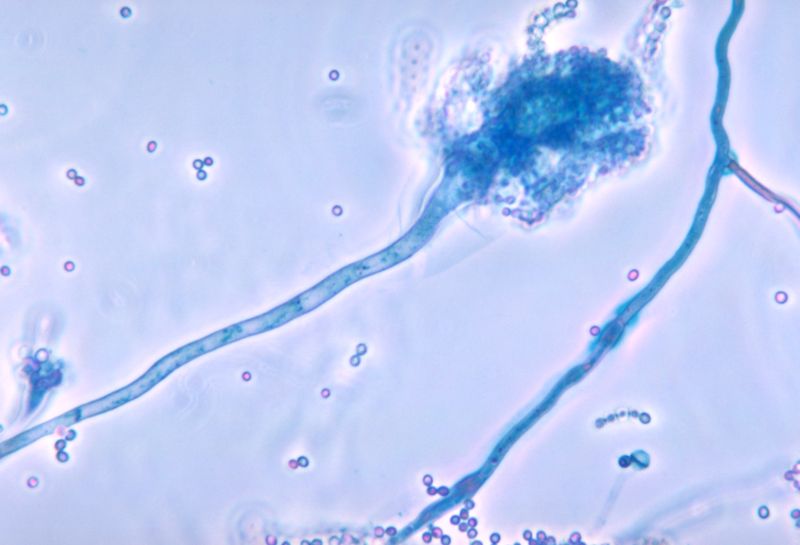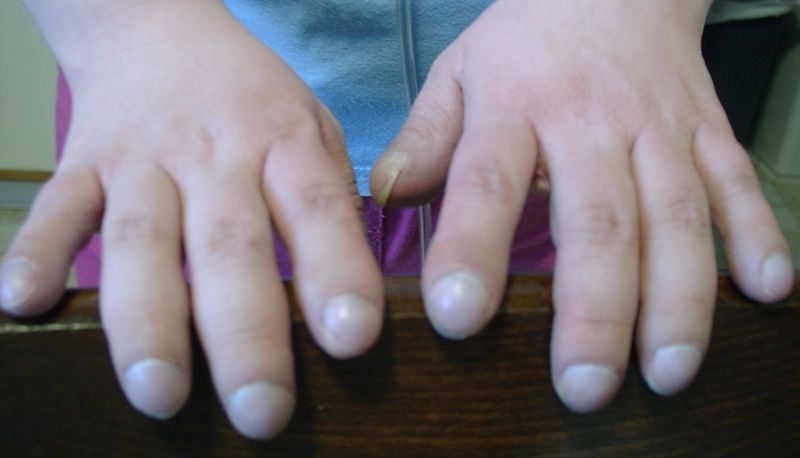Cystic fibrosis history and symptoms
Editor-In-Chief: C. Michael Gibson, M.S., M.D. [1]
|
Cystic fibrosis Microchapters |
|
Diagnosis |
|---|
|
Treatment |
|
Case Studies |
|
Cystic fibrosis history and symptoms On the Web |
|
American Roentgen Ray Society Images of Cystic fibrosis history and symptoms |
|
Risk calculators and risk factors for Cystic fibrosis history and symptoms |
Overview
Symptomatic diseases
Lung and sinus disease
Lung disease results from clogging the airways due to mucus buildup and resulting inflammation. Inflammation and infection cause injury to the lungs and structural changes that lead to a variety of symptoms. In the early stages, incessant coughing, copious phlegm production, and decreased ability to exercise are common. Many of these symptoms occur when bacteria that normally inhabit the thick mucus grow out of control and cause pneumonia. In later stages of CF, changes in the architecture of the lung further exacerbate chronic difficulties in breathing.

Other symptoms include coughing up blood (hemoptysis), changes in the major airways in the lungs (bronchiectasis), high blood pressure in the lung (pulmonary hypertension), heart failure, difficulties getting enough oxygen to the body (hypoxia), and respiratory failure requiring support with breathing masks such as bilevel positive airway pressure machines or ventilators.[1] In addition to typical bacterial infections, people with CF more commonly develop other types of lung disease. Among these is allergic bronchopulmonary aspergillosis, in which the body's response to the common fungus Aspergillus fumigatus causes worsening of breathing problems. Another is infection with mycobacterium avium complex (MAC), a group of bacteria related to tuberculosis, which can cause further lung damage and does not respond to common antibiotics.
Mucus in the paranasal sinuses is equally thick and may also cause blockage of the sinus passages, leading to infection. This may cause facial pain, fever, nasal drainage, and headaches. Individuals with CF may develop overgrowth of the nasal tissue (nasal polyps) due to inflammation from chronic sinus infections. These polyps can block the nasal passages and increase breathing difficulties.[2][3]
Gastrointestinal, liver and pancreatic disease
Prior to prenatal and newborn screening, cystic fibrosis was often diagnosed when a newborn infant failed to pass faeces (meconium). Meconium may completely block the intestines and cause serious illness. This condition, called meconium ileus, occurs in 10% of newborns with CF.[4] In addition, protrusion of internal rectal membranes (rectal prolapse) is more common in CF because of increased fecal volume, malnutrition, and increased intra–abdominal pressure due to coughing.[5]
The thick mucus seen in the lungs has its counterpart in thickened secretions from the pancreas, an organ responsible for providing digestive juices which help break down food. These secretions block the movement of the digestive enzymes into the duodenum and result in irreversible damage to the pancreas, often with painful inflammation (pancreatitis).[6] The lack of digestive enzymes leads to difficulty absorbing nutrients with their subsequent excretion in the faeces, a disorder known as malabsorption. Malabsorption leads to malnutrition and poor growth and development because of calorie loss. Individuals with CF also have difficulties absorbing the fat-soluble vitamins A, D, E, and K. In addition to the pancreas problems, people with cystic fibrosis experience more heartburn, intestinal blockage by intussusception, and constipation.[7] Older individuals with CF may also develop distal intestinal obstruction syndrome when thickened faeces cause intestinal blockage.[8]
Thickened secretions also may cause liver problems in patients with CF. Bile secreted by the liver to aid in digestion may block the bile ducts, leading to liver damage. Over time, this can lead to cirrhosis, in which the liver fails to rid the blood of toxins and does not make important proteins such as those responsible for blood clotting.[9][10]
Endocrine disease and growth

The pancreas contains the islets of Langerhans, which are responsible for making insulin, a hormone that helps regulate blood glucose. Damage of the pancreas can lead to loss of the islet cells, leading to diabetes that is unique to those with the disease.[11] Cystic Fibrosis Related Diabetes (CFRD), as it is known as, shares characteristics that can be found in Type 1 and Type 2 diabetics and is one of the principal non-pulmonary complications of CF.[12] Vitamin D is involved in calcium and phosphorus regulation. Poor uptake of vitamin D from the diet because of malabsorption leads to the bone disease osteoporosis in which weakened bones are more susceptible to fractures.[13] In addition, people with CF often develop clubbing of their fingers and toes due to the effects of chronic illness and low oxygen on their tissues.
Poor growth is a hallmark of CF. Children with CF typically do not gain weight or height at the same rate as their peers, and occasionally are not diagnosed until investigation is initiated for poor growth. The causes of growth failure are multi–factorial and include chronic lung infection, poor absorption of nutrients through the gastrointestinal tract, and increased metabolic demand due to chronic illness.
Infertility
Infertility affects both men and women. At least 97 percent of men with cystic fibrosis are sterile.[14] These men make normal sperm but are missing the tube (vas deferens), which connects the testes to the ejaculatory ducts of the penis.[15] Many men found to have congenital absence of the vas deferens during evaluation for infertility have a mild, previously undiagnosed form of CF.[16] Some women have fertility difficulties due to thickened cervical mucus or malnutrition. In severe cases, malnutrition disrupts ovulation and causes amenorrhea.[17]
References
- ↑ Rowe SM, Miller S, Sorscher EJ. Cystic fibrosis. N Engl J Med. 2005 May 12;352(19):1992–2001. PMID 15888700
- ↑ Maldonado M, Martinez A, Alobid I, Mullol J. The antrochoanal polyp. Rhinology. 2004 Dec;42(4):178-82. Review. PMID 15626248
- ↑ Ramsey B, Richardson MA. Impact of sinusitis in cystic fibrosis. Allergy Clin Immunol. 1992 Sep;90(3 Pt 2):547-52. PMID 1527348
- ↑ Eggermont E, De Boeck K. Small-intestinal abnormalities in cystic fibrosis patients. Eur J Pediatr. 1991 Oct;150(12):824-8. Review. PMID 1743211
- ↑ Kulczycki LL, Shwachman H. Studies in cystic fibrosis of the pancreas; occurrence of rectal prolapse. N Engl J Med. 1958 Aug 28;259(9):409-12. PMID 13578072
- ↑ Cohn JA, Friedman KJ, Noone PG, Knowles MR, Silverman LM, Jowell PS. Relation between mutations of the cystic fibrosis gene and idiopathic pancreatitis. N Engl J Med. 1998 Sep 3;339(10):653-8. PMID 9725922
- ↑ Malfroot A, Dab I. New insights on gastro-oesophageal reflux in cystic fibrosis by longitudinal follow up. Arch Dis Child. 1991 Nov;66(11):1339–45. PMID 175564
- ↑ Khoshoo V, Udall JN Jr. Meconium ileus equivalent in children and adults. Am J Gastroenterol. 1994 Feb;89(2):153-7. PMID 8304294
- ↑ Williams SG, Westaby D, Tanner MS, Mowat AP. Liver and biliary problems in cystic fibrosis. Br Med Bull. 1992 Oct;48(4):877-92. PMID 1458306
- ↑ Colombo C, Russo MC, Zazzeron L, Romano G. Liver disease in cystic fibrosis. J Pediatr Gastroenterol Nutr. 2006 Jul;43 Suppl 1:S49-55. PMID 16819402
- ↑ Moran A, Pyzdrowski KL, Weinreb J, Kahn BB, Smith SA, Adams KS, Seaquist ER.Insulin sensitivity in cystic fibrosis. Diabetes. 1994 Aug;43(8):1020–6. PMID 8039595
- ↑ Alves Cde A, Aguiar RA, Alves AC, Santana MA. Diabetes mellitus in patients with cystic fibrosis. J Bras Pneumol. 2007 Apr;33(2):213-21. PMID 17724542
- ↑ Haworth CS, Selby PL, Webb AK, Dodd ME, Musson H, McL Niven R, Economou G, Horrocks AW, Freemont AJ, Mawer EB, Adams JE. Low bone mineral density in adults with cystic fibrosis. Thorax. 1999 Nov;54(11):961-7. PMID 10525552
- ↑ McCallum TJ, Milunsky JM, Cunningham DL, Harris DH, Maher TA, Oates RD. Fertility in men with cystic fibrosis: an update on current surgical practices and outcomes. Chest. 2000 Oct;118(4):1059–62. PMID 11035677
- ↑ Dodge JA. Male fertility in cystic fibrosis. Lancet. 1995 Sep 2;346(8975):587-8. PMID 7650999
- ↑ Augarten A, Yahav Y, Kerem B, Halle D, Laufer J, Szeinberg A, Dor J, Mashiach S, Gazit E, Madgar I. Congenital bilateral absence of vas deferens in the absence of cystic fibrosis. Lancet 344: 1473–1474, 1994. PMID 7968122
- ↑ Gilljam M, Antoniou M, Shin J, Dupuis A, Corey M, Tullis DE. Pregnancy in cystic fibrosis. Fetal and maternal outcome. Chest. 2000 Jul;118(1):85–91. PMID 10893364